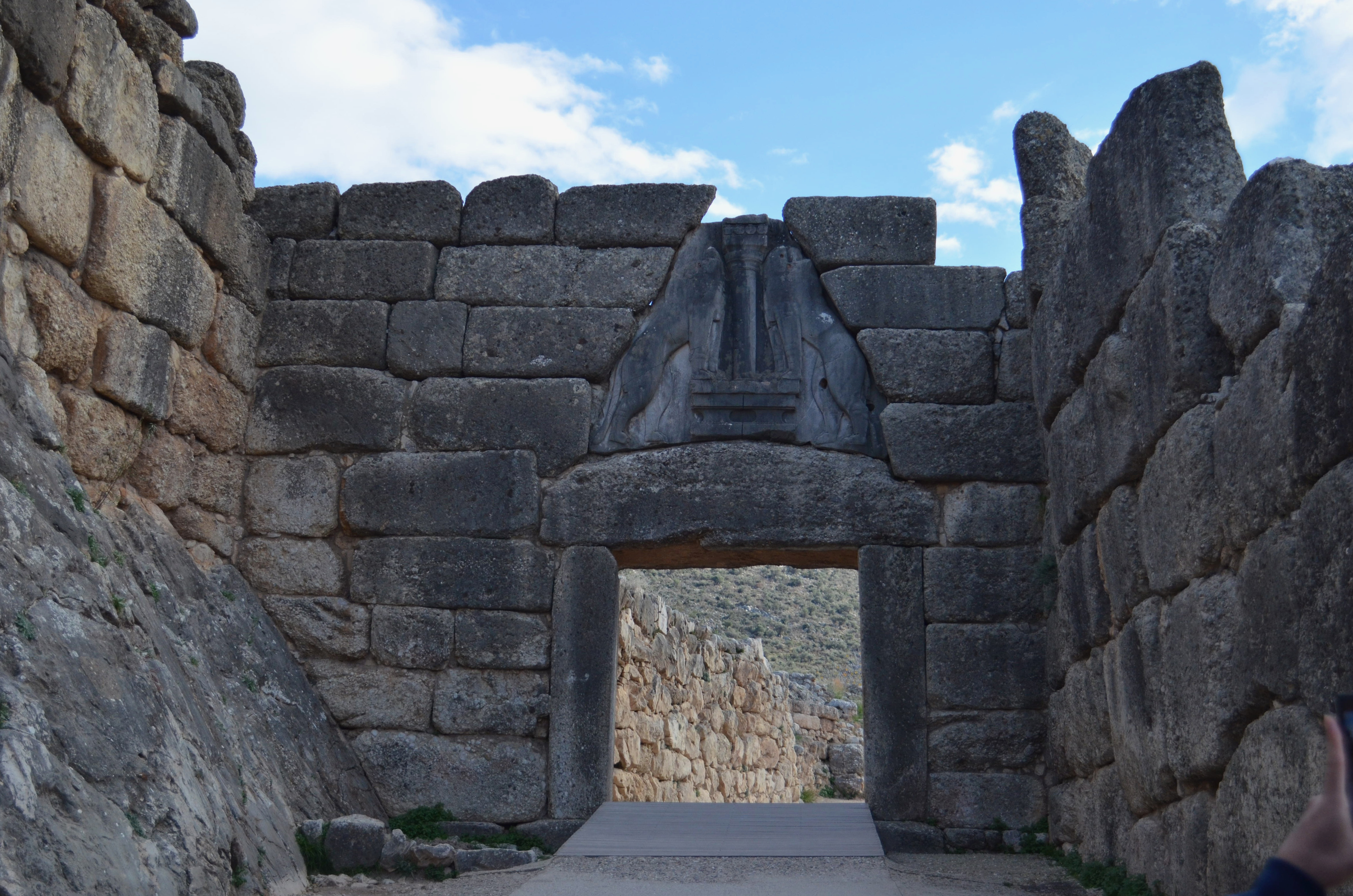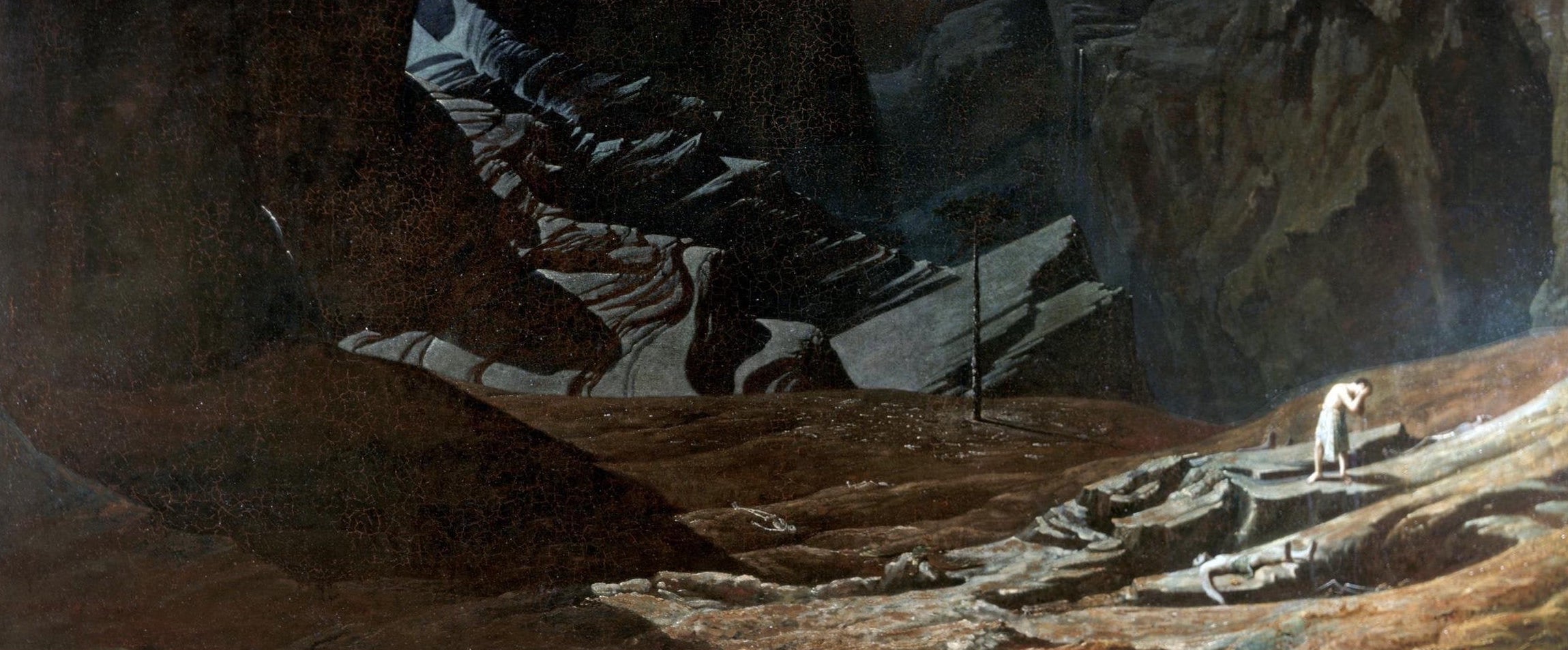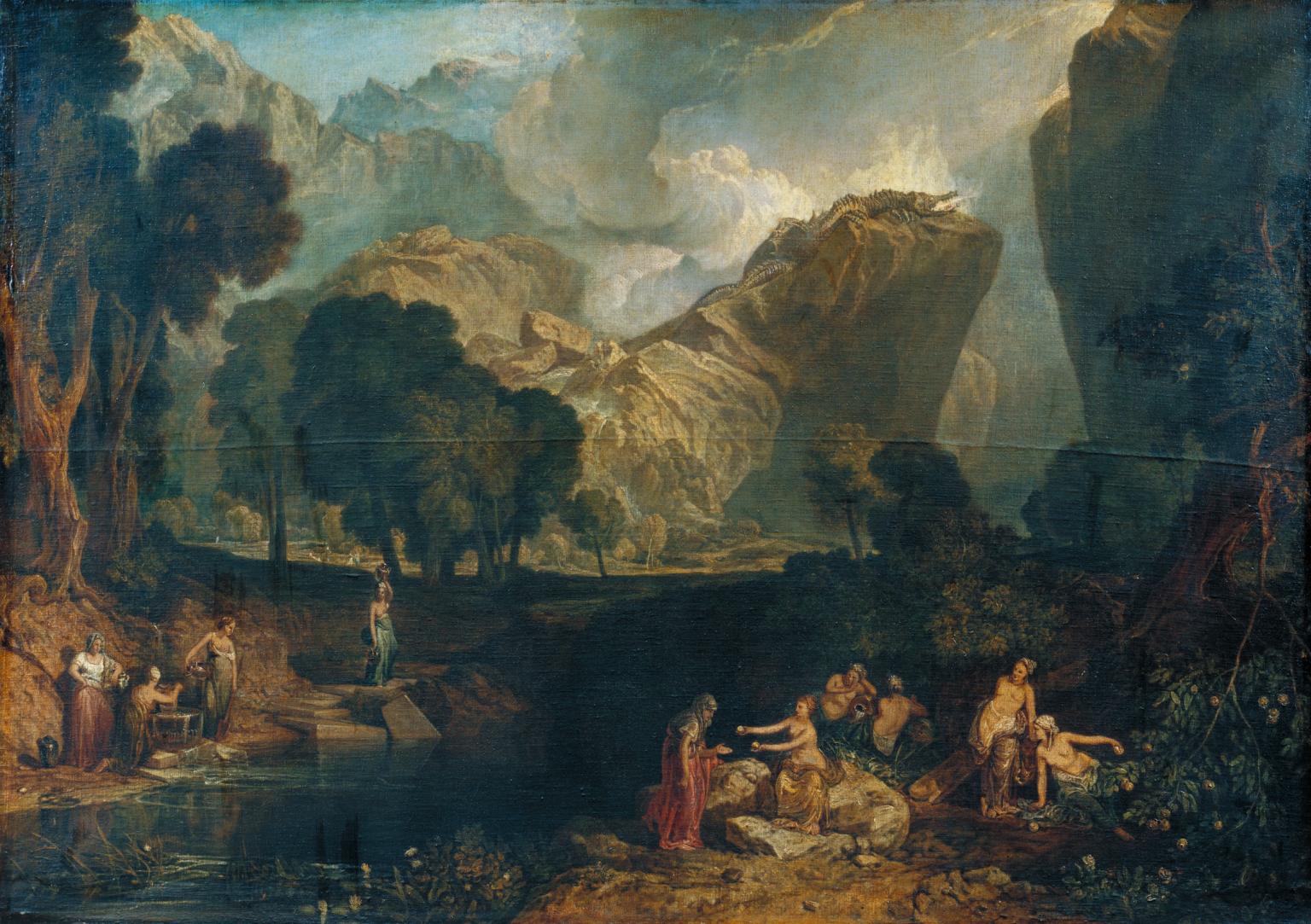The tour guide is expostulating with equal measures of enthusiasm and malleable exactitude on the Golden Mean. We listeners are scattered in a loose, meditative but fidgety herd of participants of all horizons, around the orchestra of the Theatre of Epidaurus.
The sun is warm enough to take the bite off the Peloponnesian winter air, the pack of stray dogs that accompanied us from the entrance has disappeared: potential snacks were clearly not forthcoming, and besides, they have likely heard the guide before. The other members of our tour group are nodding thoughtfully at each observation: the gist of the expostulation is that the lower rows of seats measure exactly 1.618 times the height of the upper tier. If you measure the human body, the guide is explaining, the distance from the head to the knees is exactly the golden ratio as well (more thoughtful nods). Additionally, if you compare… I lose interest in this interminable dithyramb to the inexplicable genius of the Ancient Greeks. My mind wanders.
Limestone Seats and Golden Means: The Theatre of Epidaurus
If you take into account that the upper tier of seats, so crucial to the calculation, was added by the Romans close on five centuries later, so much for the Golden Ratio. Polykleitos’ original structure, built around 340 BC, had thirty-four rows, the Romans added twenty-one more in the 2nd century AD, but it is likely the additions were guided more by the height of the hill than by considerations of ideal proportion. The theatre at the Sanctuary saw use for seven hundred years, until the Goths invaded the Peloponnese in 395 AD. Thirty years later, Theodosius the Great banned all pagan activities throughout Greece and the Sanctuary was abandoned. Asleep under a tree-covered slope on Mount Kynortio the theatre remained miraculously intact until 1881, when it was excavated and restored under the auspices of the Greek Archaeological Society.[1]
The acoustics are truly astonishing and the guide’s delivery would not make any ancient tragedian blush. The nature and structure of the limestone seats (their incline is 26 degrees) dull the lower frequencies and allow the higher to rebound. It is an engineering marvel, and one that has been stumping observers for a long time. In Vitruvius’ words: “By the rules of mathematics and the method of music, they sought to make the voices from the stage rise more clearly and sweetly to the spectators’ ears… by the arrangement of theatres in accordance with the science of harmony, the ancients increased the power of the voice.” They also discovered “virtual pitch” without naming it, when the brain, filling in the missing frequencies, perceives an enhanced impression of clarity.
The Expensive Seats: the dignitaries’ benches in the theatre
˜ ˜ ˜
We wander off, up the tiers; half the group remains in an informal queue as acquaintances and family take up stations in the hollow to hear hands clap, coins drop, or respond by gesture to hellos from the stage. Natural one-way sound is a novel experience, though it is unlikely that, contrary to popular belief, matches striking and whispers carry much farther than the first rows.
My mind is here and it is not, as with every place where residual human experience is so concentrated. I arrive at the last row of seats, the cheap ones, where you get not the best view, but the widest, where the action remains framed by the context and above all the consciousness of your own position in relation.
That is how we see history, from those cheap seats. The front row seats have long been vacated, we are spectators embedded in context and signification. The action itself takes on a supporting role in a wider scene, our position tends to place context above all else. (Decontextualization of history is usually done for political, or most especially, religious reasons, the goal being a foreshortening of time to restore the immediacy of a tragic, unjust, miraculous or otherwise significant event.)
Romantics Abroad: View of the Acropolis from the Pnyx, by the Swiss painter Rudolph Müller (1802–1885) Oil on canvas, 87 x 62 cm, 1863
History is syncretic, gathering to itself the elements of its own after-the-fact clarity (or lack of) to acquire meaning. History makes better reading abridged, so we take the best bits, we personalize (unconsciously), we politicize (intentionally) or we subscribe to schools of thought because we are happy to delegate the hard work of making sense of things to others. We end up being our own tour guides through history, simultaneously expostulating and nodding thoughtfully as we tell ourselves stories. Or nodding off, as I am tempted to do as the guide drones on.
Post-Romantics and Traffic Jams: today’s Acropolis from the Plaka
As for the Golden Mean, it is as seductive as it is elusive.[2] Despite its presence in Ancient Egypt and in Pythagorean tradition, Euclid is the first to furnish a definition. Luca Pacioli penned the earliest known treatise on the subject: Divina Proportione, in the late 15th century. Nonetheless, we have to wait three more centuries for the first published use, in Martin Ohm’s 1835 Pure Elementary Mathematics.
It is variously referred to as the golden or divine ration, mean, proportion, number, section or cut. The symbol for the equation is tau τ (the cut) or phi Φ, the first letter of the name of the near-legendary Greek sculptor Phidias. So much has been written about the Golden Mean that I won’t try to resume it here, but much scholarship takes coincidence for divine design and assigns intent to happenstance. It is a mixed bag at 1.618… more interesting philosophically than mathematically, though there is an undeniable poetry to the mathematics. While it is more Euclid than Fibonacci, whose spiral is best approached in nature, it remains a quintessentially human proportioning of our view of the universe and our eternal quest for meaning through recognition of form.[3]
But we are back on the bus, and my musings are interrupted by the guide who is recounting the tale of Argos and its storied past.
In an Ideal(ised) World: an almost Elysian vision of Ancient Greece. Mycenae, from The Life and Culture of the Ancient Greeks by Jacob von Falke, translated by N. G. Politis, 1887.
˜ ˜ ˜
The past is a foreign country we enthusiastically explore, eager tourists guided as much by instinct as by knowledge, as much by story as by history. We have been digging and poking around in the past for a long time, both figuratively and physically, our interrogations driven by greed for antiquities and knowledge, often in a brazen combination of high-handed entitlement and genuine passion. Happily, modern armchair forays into the past do far less damage. Nonetheless, we are inattentive archaeologists in our diggings, burrowing single-mindedly through layer upon layer, just as Heinrich Schliemann did at Hisarlik, pursuing his dreams of Troy.[4] In 1873, only three people in the world, Heinrich Schliemann and Frank and Frederick Calvert, the landowners of a desolate stretch of terrain near Tenedos on the Turkish coast, believed that Troy might have been an actual city. The intellectual community scoffed at the idea it was more than legend. Schliemann‘s conviction was based on a romantic reading of the Iliad; simultaneously fervent secular hermeneut and pragmatic euhemerist, his hunch was right. In exchange for his firman, or permission to dig, he promised the Turkish government that he would turn over all treasure he discovered, but when he stumbled on the funerary urn containing “Priam’s treasure,” he packed it up in a basket and he and his wife sped under cover of darkness to the coast and a waiting boat – thief in the night, a dreamer with dirt under his nails.
The New Helen: Sophia Schliemann (née Engastromenos) wearing treasures unearthed at Hisarlik.
Consequently persona non grata in Turkey, Schliemann became something of an archaeological refugee. He tried Knossos, but Evans was already there, digging and dreaming of minotaurs and labyrinths and creating an idealized Art Nouveau vision of the Minoans. Schliemann turned his mind to Mycenae.
And I too… we are herded back on our bus (the dogs reappear, just in case snacks might miraculously materialize) and we continue on. Next stop: Mycenae. The bus speeds past Tiryns: massive cyclopean walls glimpsed though a chain link fence. The driver has no plans to stop, he has a schedule to respect.
Schliemann also saw Tiryns en passant, although he certainly lingered far longer than we. “In the south-eastern corner of the plain of Argos, on the west and lowest and flattest of those rocky heights which here form a group, and rise like islands from the marshy plain, at a distance of 8 stadia, or about 1500 m. from the Gulf of Argos, lay the prehistoric citadel of Tiryns, now called Palaeocastron.” (Heinrich Schliemann; Tiryns; 1885)
Pausanias had visited well before him. In the 2nd century it was already a place of legend: “Going on from here[5] and turning to the right, you come to the ruins of Tiryns… The wall, which is the only part of the ruins still remaining, is a work of the Cyclopes made of unwrought stones, each stone being so big that a pair of mules could not move the smallest from its place to the slightest degree. Long ago small stones were so inserted that each of them binds the large blocks firmly together.” (Pausanias; Description of Greece)
Tiryns was of course the seat of Eurystheus. Herakles dwelled twelve years in the city, instructed by the Pythia of Delphi to do so after his madness had caused him to slay his own children. “And she told him to dwell in Tiryns, serving Eurystheus for twelve years and to perform the ten labours imposed on him, and so, she said, when the tasks were accomplished, he would be immortal.” (One imagines Herkales, slipping and cursing in the mud, dragging a reluctant hellhound Cerberus across the marshy plain to manhandle him, claws scrabbling on the tiled floors, before his master in the Megaron. Indeed, Eurystheus may have regretted some of the challenges – he took refuge in a large jar when Herakles dragged home the Erymanthian Boar. As for Cerberus, he was returned to Hades afterwards.)
The Grand Tour: illustrations from GREECE: Painted by John Fulleylove, R.I. Described by the Rev. J. A. M”Clymont, M.A., D.D., published by A. AND C. Black, London, 1906
From left to right, following the cover and the Acropolis, Athens; I have kept the original captions.
THE THEATRE OF EPIDAURUS: Presumably the work of the younger Polykleitos; the auditorium (koilon) hollowed out of the side of the hill, as is usual in Greek theatres. In the diazoma, or horizontal gangway, half-way up the side of the auditorium, are thrones or seats of honour. The orchestra, marked by a circle of white marble, is clearly shown, and also the foundations of the stage buildings. By an act of barbarism, which has sadly ruined the artistic interest of this, the most beautiful ancient Greek theatre, the marble proscenium decorated with engaged Ionic columns has been removed, as not being part of the original design of the building. One of the great gateways opening into the passage (parados) leading to the orchestra occupies the lower middle part of the drawing.
TIRYNS. THE GATE OF THE UPPER CASTLE: The gate post to the left (west) 10½ feet high, is complete, with the rebate and the hole for the insertion of the strong bar to secure the gate. Only half of the right (eastern) post remains. Over it we see the massive outer rampart between the main gate and the gate of the Upper Castle.
THE ACROPOLIS OF MYCENÆ FROM THE SOUTH-WEST, BACKED BY THE IMPOSING FORM OF MOUNT ELIAS: The gorge to the right is the valley which served as a defence for the Acropolis on the south side. The piece of road to the left is within a few paces of the famous bee-hive tomb known as the Treasury of Atreus.
MYCENÆ, SHOWING THE SITE OF THE FAMOUS DISCOVERIES OF SCHLIEMANN: The mass of so-called cyclopean masonry, on the right, buttresses the upper part of the Acropolis of Mycenæ. The wall at right angles to it contains the Lion Gate, and the large triangular stone above the lintel is the back of the well-known relief of lions or lionesses regardant, probably the most ancient piece of sculpture in Greece. In the foreground is shown the singular double wall and gateway of the enclosure, called by Schliemann the Agora, within which he found the treasures of Mycenæan art now in the Central Museum in Athens.
˜ ˜ ˜
My mind moves on from Herakles as the bus climbs from the Argolid plain, Mycenae is unspectacular, despite the steep climb; set, as Homer says, “in a nook of Árgos,” with a natural citadel formed by the ravines between the mountains of Hagios Elias (Ayios Ilias) and Zara, which overshadow it to the left and right. The bus pauses near the Treasury of Atreus. This is the aperitif, a cyclopean tomb built into the hill facing the acropolis. It is otherworldly, if only by the size of the blocks – the slab of the lintel alone weighs some 120 tons – and the unusual triangular aperture above it, necessary to distribute weight to the walls. Each course of blocks overlaps the lower, creating layer upon corbelled layer until they meet in the middle, the lofty dome is nearly 12 meters above our heads. Its emptiness (except for tourists with cell phones and cameras) creates a prodigiously otherworldly space, there is nothing for the eye to measure and compare; it could have been built by Polyphemus and his kind.
Regal: The Acropolis of Mycenae
It is a tholos, or beehive tomb. Built around 1250 BC, it remained the tallest and widest dome for over a thousand years, until the construction of the Temple of Hermes in Baiae, near Naples, locality famous for Caligula’s expensive stunt in rebuttal of the acerbic observation of Thrasyllus of Alexandria. The top of the dome would have projected above the hill, and been plastered white, like some gigantic egg half-buried. As for us, we clamber back on the bus to drive a few yards to the last stop: Mycenae itself.
Monumental: The Treasury of Atreus
According to tradition, Perseus, exiled from Argos, set up house just across the plain. He is reputed to have brought in foreign help – the Cyclopes – to build the walls of Mycenae.[6] As you approach, it certainly seems an apt description. The cyclopean style is mixed with the later ashlar: in the former, the courses are wandering and irregular, the latter uses blocks of a similar size, but laid in straight course. Neither depended on the use of mortar. The walls are thick, as much as 20 to 30 feet in places, the interiors filled with smaller blocks and rubble. The Mycenaeans essentially built rugged cliffs around their cities.
What it actually resembled in its heyday may well reside forever in the realm of speculation, but it must certainly have been impressive. The Mycenaeans were barbarian kings in gilded halls, burying their dead in shaft, covering their dead kings’ faces with masks of beaten gold. Of gold and bronze they had aplenty, but no iron. In Hesiod’s words: “Their gear was of bronze, they had bronze houses; they tilled the soil with bronze; black iron there was none.” They wore helmets made of the tusks of boars, and wore odd cylindrical shells of bronze into battle. They are a far cry from our traditional visualization of the Iliad; they fought as far away as Egypt, and certainly traded and traveled throughout the Middle East, and far north perhaps as the Danube and by sea as far west as Italy and perhaps Spain.
The King in the Golden Mask: the so-called Mask of Agamemnon, discovered by Heinrich Schliemann at Mycenae.
At the height of its power, around 1350 BC, the citadel and settlement may have housed thirty thousand people. The period known as Mycenaean Greece, the last centuries of the Bronze Age, are generally considered to have spanned half a millennium, from 1600 to 1100 BC. They kept the first written Greek records. They were a people to be reckoned with. They overtook Minoan Crete, occupying Knossos, even establishing bases as far away as Rhodes. The rulers of Mycenae wielded real power.
Mycenae: The Lion Gate
It is not hard to imagine now. The headless lions still twist their necks to face us, their powerful forelimbs resting on the altars that hold the column between them. They are, with the exception of the heads, surprisingly intact.[7] The lines are clean and sophisticated, but the symbolism is archaic. The column is found elsewhere, and from far back in history, it is the tree guarded by griffons in Mesopotamia, the symbol upholding the roof of the kingdom, but also the roof of the world. The approach to Mycenae, the passage under the Lion Gate and the winding street up to the Megaron must have been awe-inspiring.
Then, for a reason which eludes historians even today, the empire declined. The period following, from the 11th to the 8th centuries BC is commonly known as the Greek Dark Ages, followed by the rise of Classical Greece.[8] Whatever the causes, Mycenae receded into a land of myth and grazing sheep, the fate of so many once-great bastions, where their deeds are celebrated in legend and shepherds camp within their broken walls.
It slumbered, except in the pages of Homer. Pausanias passed by around 160 AD, but only 1500 years later do we find the next mention by Franceso Grimani, in 1700. (Grimani used Pausanias’ description of the Lion gate to identify the ruins: “Parts Of The City Wall Remain, Among Them The Gate, Surmounted By Lions. They Say It Is The Work Of The Cyclopes, Who Made For Proteus the Walls at Tiryns.”)
Mycenae sleeping: little changed from the time of Pausanias. Views in Greece, from Drawings by Edward Dodwell Esq. F.S.A &c., London, Rodwell and Martin, 1819.
Then, Schliemann arrived and industriously set to work. Here is an excerpt from his journal, published in 1878:
“Mycenae, Sept. 30, 1876.
Since the 9th inst. I have continued the excavations with the greatest energy, employing constantly125 workmen and five horse-carts, and the weather being beautiful I have made excellent progress. In the Treasury, in which Mrs. Schliemann is excavating, we work with thirty labourers and two horse-carts, and find the very greatest difficulty in removing the hundreds of huge wrought stones which have fallen from the vault…”
He dug here and there outside the walls, then moved into the citadel. He excavated the shaft graves just to the right inside the Lion Gate; in Grave V he found his grail: the golden Mask of Agamemnon. As was the case for Priam’s Treasure (in which he dressed his wife Sophia, dubbing her a “second Helen”) Schliemann felt he was finally holding the veritable proof of the underlying truth of the Iliad. It was wishful thinking of course, the mask is indeed royal, but of the wrong date to grace Agamemnon’s royal visage, had he existed.
The Foreign Country of the Past:Tourist seeking a better seat
Nor can we count on the Trojan war as a real event, although there is proof enough that one of the many layers that compose the tell of Hissarlik was set afire, the events described by Homer are historically ambiguous.
Mycenae began its journey into epic legend and myth long ago. It was remembered as the Third or Bronze Age of Hesiod. In his poem Works and Days, Hesiod listed Five Ages. The first was the mythical Golden Age, or age of Cronus, precursor of the Christian Paradise before the Fall; the Sliver Age, under the dominion of Zeus, when humans lived a century. The men of the Bronze Age were battle-hardened, eager for war, their souls destined for Hades. Their Age was destroyed by Zeus, who unleashed the Flood of Deucalion. The Heroic Age, the time of the heroes of the Trojan War, and after death could hope for an eternity in the Fields of Elysium. The fifth age, the Age of Iron, was Hesiod’s own.
Monumental: Polyphemus’ handiwork
So even in the 7th century, Mycenae had receded into a world grander than history, straddling two mythic ages that paralleled history: the early immigrants from the Anatolia, the Caucasus and Iran, wielding weapons and tools first of copper, then bronze, and the Mycenaean kingdoms with their cultural inheritance from the Minoans, barbarian kings in golden halls, belligerent rulers of the Aegean, their ranks filled with heroes.
Modern archaeology brings their reality back to life, inevitably confronting history and story, the former somehow insinuating that the latter is less useful to our modern sensibilities. To me it seems they need to be treated with the same respect, because neither is entirely true or wholly false.
Because, when the dust settles, it is without importance. Was there a real King Arthur, a real Robin Hood or a William Tell? Whatever individuals may have existed, their existences are relatively unremarkable components of something far richer, and the fierce debates to prove some version of them actually lived and breathed are largely pointless quarrels. Their mist-shrouded origins are the source of their syncretic power. Alexander the Great, for example, or Charlemagne, gathered marvels in their wakes, but as their real lives are well-described, they have little room in their baggage for anything more than the occasional anecdote.
Our personal nostalgia avidly inserts itself into the wider horizons of things past. We are the willing prisoners of linearity, of the instant fled, of things slipping though our grasp. Now wonder the Romantic landscape was one of lone and level sands… we shelter in the shadow of those trunkless legs of Shelley’s Ozymandias. Forays into history are rarely dispassionate affairs.
˜ ˜ ˜
In the words of Ursula K. LeGuin: “History is one way of telling stories, just like myth, fiction, or oral storytelling. But over the last hundred years, history has pre-empted the other forms of storytelling because of its claim to absolute, objective truth. Trying to be scientists, historians stood outside of history and told the story of how it was. All that has changed radically over the last twenty years. Historians now laugh at the pretense of objective truth. They agree that every age has its own history, and if there is any objective truth, we can’t reach it with words. History is not a science, it’s an art.”
We file back to board the bus, the trip back to Athens, punctuated by the inevitable and excruciating shopping stop at a pottery shop in a nearby town, ends in traffic jams and darkness, until we are dropped at our hotel. The guide had rambled a little less than as Epidaurus; marrying fact to fancy in Mycenae is best left to the imagination.
The world is full of such places, places where we can gain a glimpse of that intangible entelechy that suddenly juxtaposes history and story. Both contain elements of truth of differing nature. The past is a foreign country, the present is the temporal telescope through which we see what we can, or, for the majority of us, as we are not historians, make do with what we are offered: the view from the cheap seats.
……………FOOTNOTES……………..
[1] The restoration was undertaken in several stages: in 1907, 1957 and most recently from 1988 to 2016. Modern performances began in 1960, with Maria Callas performing Norma in 1960 and Medée in 1961.
[2] Anecdote: I initially typed in “eleusive,” a tempting Freudian neologism to synthesize Eleusis with wider mysteries. Happily, the spelling corrector dispelled such a notion.
[3] The Golden Section has been applied, more or less generously and often quite leniently, to literally everything, from the pyramids at Giza to the chambered nautilus and more, though to my knowledge, it has been little applied to the architecture of the Far East.
[4] Schliemann was an inveterate embroiderer of tales, so often repeating the story of his childhood discover of the Trojan War and dreaming dreams filled with Greek heroes that he may actually have come to believe it himself. Vocation and passion have a way of sending roots deep into our childhoods.
[5] Pausanias was travelling in the opposite direction, from Argos to Epidaurus.
[6] For such gigantic beings, the Cyclopes are hard to pin down as well. Described by Homer as an indolent race of man- eating shepherds in south-western Sicily, of whom we know only one by name: the one-eyed Polyphemus who is famously blinded by Odysseas. Homer neglects to tell us if Polyphemus’ one eye was a feature of his kind. Later tradition describes them as servants of Hephaestus, happily laboring under Aetna. No longer shepherds, they are makers of weapons and armour for the gods. Two are named: Pyracmon and Acamas. The Cyclopes who built Argos, Tiryns and Mycenae hail from Thrace, their name derived from a King Cyclops.
[7] The heads were apparently made of a different stone or perhaps of gold, affixed to the main limestone relief. There is some speculation that they also had eagle’s heads, and are not lions, but wingless griffins or even that they had human heads. The lintel upon which they rest, secure in their corbelled triangle, weighs some 18 tons.
[8] The Classical Greeks ascribed the decline to the Dorian Invasion around 1100 BC, the 19th century to the mysterious Sea Peoples; it is very likely a combination of internecine strife, changing maritime influence and population shifts. We may never know for certain. It sent contingents to Thermopylae and Plartea during the Persian Wars. When it was besieged and thrown down by neighbouring Argos in 468 BC, it was no longer a center of power. Later. It was reoccupied during the Hellenic Period; a theatre being built over top of the Tomb of Clymenestra. When Pausanias stopped by, it was inhabited only by sheep.


















